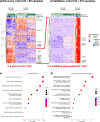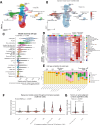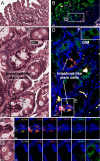A spatial transcriptomic signature of 26 genes resolved at single-cell resolution characterizes high-risk gastric cancer precursors
- PMID: 40000871
- PMCID: PMC11861308
- DOI: 10.1038/s41698-025-00816-w
A spatial transcriptomic signature of 26 genes resolved at single-cell resolution characterizes high-risk gastric cancer precursors
Abstract
Gastric cancer precursors demonstrate highly-variable rates of progression toward neoplasia. Certain high-risk precursors, such as gastric intestinal metaplasia with advanced histologic features, may be at up to 30-fold increased risk for progression compared to lower-risk intestinal metaplasia. The biological differences between high- and low-risk lesions have been incompletely explored. In this study, we use several clinical cohorts to characterize the microenvironment of advanced gastric cancer precursors relative to low-risk lesions using bulk, spatial, and single-cell gene expression assays. We identified a 26-gene panel which is associated with advanced lesions, localizes to metaplastic glands on histopathology, and is expressed in aberrant mature and immature intestinal cells not normally present in the healthy stomach. This gene expression signature suggests an important role of the immature intestinal lineages in promoting carcinogenesis in the metaplastic microenvironment. These findings may help to inform future biomarker development and strategies of gastric cancer prevention.
© 2025. The Author(s).
Conflict of interest statement
Competing interests: The authors declare no competing interests.
Figures





Update of
-
A spatially mapped gene expression signature for intestinal stem-like cells identifies high-risk precursors of gastric cancer.bioRxiv [Preprint]. 2023 Sep 22:2023.09.20.558462. doi: 10.1101/2023.09.20.558462. bioRxiv. 2023. Update in: NPJ Precis Oncol. 2025 Feb 25;9(1):52. doi: 10.1038/s41698-025-00816-w. PMID: 37786704 Free PMC article. Updated. Preprint.
References
-
- Sung, H. et al. Global Cancer Statistics 2020: GLOBOCAN Estimates of Incidence and Mortality Worldwide for 36 Cancers in 185 Countries. CA Cancer J. Clin.71, 209–249 (2021). - PubMed
-
- Correa, P. Human gastric carcinogenesis: a multistep and multifactorial process–First American Cancer Society Award Lecture on Cancer Epidemiology and Prevention. Cancer Res. 52, 6735–6740 (1992). - PubMed
-
- Sonnenberg, A., Lash, R. H. & Genta, R. M. A national study of Helicobactor pylori infection in gastric biopsy specimens. Gastroenterology139, 1894–1901.e1892 (2010). - PubMed
-
- Sonnenberg, A. & Genta, R. M. Changes in the gastric mucosa with aging. Clin. Gastroenterol. Hepatol.13, 2276–2281 (2015). - PubMed
Grants and funding
- P01CA26577/U.S. Department of Health & Human Services | NIH | National Cancer Institute (NCI)
- R01 HG006137/HG/NHGRI NIH HHS/United States
- P01 CA265772/CA/NCI NIH HHS/United States
- R01HG006137/U.S. Department of Health & Human Services | NIH | National Cancer Institute (NCI)
- K08CA252635/U.S. Department of Health & Human Services | NIH | National Cancer Institute (NCI)
LinkOut - more resources
Full Text Sources

